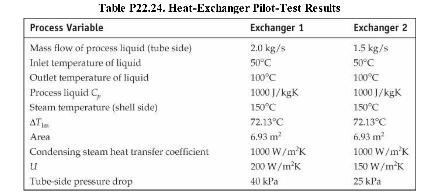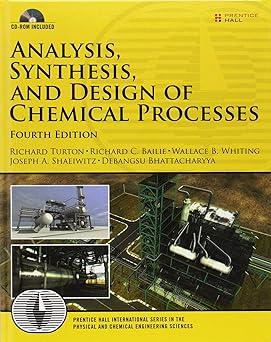Two heat exchangers of equal area have been designed to heat a certain process fluid from (50^{circ}
Question:
Two heat exchangers of equal area have been designed to heat a certain process fluid from \(50^{\circ} \mathrm{C}\) to \(100^{\circ} \mathrm{C}\) using condensing saturated steam at \(150^{\circ} \mathrm{C}\). The designs of the two exchangers are different and result in different pressure drops and different overall heat transfer coefficients. Pilot-test results for the two heat exchangers operating individually are given in Table P22.24 for a single set of operating conditions.
Table 22.24

In the plant, these two exchangers are now to be piped in parallel, and at the current operating conditions, the pressure drop across both heat exchangers is measured at \(52 \mathrm{kPa}\).
Assuming that the physical properties and inlet temperature of the process stream (in the tube side) are the same as given in Table P22.24 and that condensing steam is used in the shell side, answer the following questions:
a. What is the mass flowrate of process fluid through Exchanger 1?
b. What is the mass flowrate of process fluid through Exchanger 2?
c. What is the new overall heat transfer coefficient for Exchanger 1?
d. What is the new overall heat transfer coefficient for Exchanger 2?
e. If the process exit stream from Exchanger 1 is to be maintained at \(100^{\circ} \mathrm{C}\), what must be the temperature of the condensing steam that is fed to this exchanger?
f. If the process exit stream from Exchanger 2 is to be maintained at \(100^{\circ} \mathrm{C}\), what must be the temperature of the condensing steam that is fed to this exchanger?
g. Under another set of conditions, if the two exchangers were piped in parallel and the flow measured through Exchanger 1 was \(3.1 \mathrm{~kg} / \mathrm{s}\), what would the flow be through Exchanger 2?
Step by Step Answer:

Analysis Synthesis And Design Of Chemical Processes
ISBN: 9780132618120
4th Edition
Authors: Richard Turton, Richard C. Bailie, Wallace B. Whiting, Joseph A. Shaeiwitz, Debangsu Bhattacharyya





